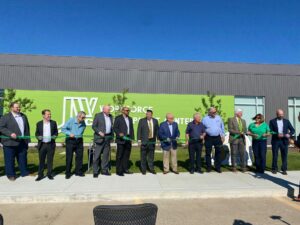Chicago — Governor JB Pritzker has signed a package of bills to incentivize corporate development and attract new businesses and capital investments to Illinois.
The bill also expands River’s Edge Redevelopment Zones to seven new downstate communities, which will enable them to leverage new incentives to attract investments, create jobs and invest in their communities. The bill adds zones in Moline, East Moline, Ottawa, LaSalle, Peru, Rock Island and Quincy.
“The Great River Economic Development Foundation, The Quincy Area Chamber of Commerce, and The District teamed together this past year to advocate for Quincy’s inclusion into the River’s Edge Program,” said Kyle Moore, GREDF President/CEO. “All three boards recognized that inclusion into the program would give a shot in the arm to revitalize historic properties in Quincy. The most important aspect of the River’s Edge Program is a 25 percent state tax credit to renovate historic properties. Without the River’s Edge program, this can be an arduous administrative process with limited state funds available, making it extremely difficult for local developers to utilize. We thank the Governor and the General Assembly for their bipartisan support for our River’s Edge initiative. We believe this will lead to many exciting projects in the future.”
The omnibus bills, HB5005, include investments in tax credit programs for the film industry and research and development projects across the state, as well as for the Economic Development for a Growing Economy (EDGE) and Reimagining Energy and Vehicles (REV) programs. The bills also build on Illinois’ growing status as a tech hub and reduce red tape for the Blue Collar Job Act (BCJA).
“Since day one of my administration I have been laser-focused on ensuring businesses that uplift Illinoisans and our economy see the many benefits this state can offer—and that has paid off many times over,” said Governor JB Pritzker. “We’re continuing that essential work with this package of legislation, attracting new and expanded business opportunities that offer good paying jobs and build out industries of the future like EV and quantum.”
In 2023, Illinois tripled corporate investments incentivized by the Illinois Department of Commerce and Economic Opportunity (DCEO). New jobs created by the EDGE and REV programs jumped up more than 60 percent from the previous year – from 2,691 to 4,329 – with the number of retained jobs increasing exponentially, from 204 to 3,127. Updates to Illinois’ premier business development tools will make Illinois even more competitive for jobs and capital investment and could generate more than an estimated $21 billion in new state revenue into GRF over the next 30 years.
The Illinois film tax credit, created by Governor Pritzker in 2022 and expanded through 2032, offers tax credits for local labor and production expenditures and has been a key factor in Illinois landing major productions. The State’s tax credit has resulted in a $6.81 return on investment for every dollar spent on the incentive, resulting in $3.6 billion in economic activity between FY17 and FY22. 94 percent of Illinois’ current film industry economic impact is attributed to the impact of the tax credit enacted by Governor Pritzker.
The omnibus also includes:
- Recodification of eligibility for the Manufacturing Illinois Chips for Real Opportunity (MICRO) program: This law codifies quantum computing, semiconductor, and microchip companies in the R&D phase as eligible for the program while reducing initial investment requirements to allow smaller businesses to enter the market.
- Creation of a Quantum Enterprise Zone (QEZ): Designed to help position Illinois’ proposed quantum campus – funded through a $500 million bonded capital request introduced in the FY25 budget – to attract up to $11 billion in CHIPS and related federal funding and an estimated $20 billion in private investment.
- Reduction of Blue Collar Jobs Act (BCJA) Red Tape: Based on industry feedback, this change allows BCJA credits to be based on industry standard or 3rd party verified construction wages rather than the submission of monthly payroll data.
“As technology evolves, it’s important our policies do the same to maintain our state’s competitiveness and economic strength. The legislation signed today by Governor Pritzker will invest in manufacturing and supply chains, keeping Illinois at the forefront of electric vehicle development while also strengthening incentives for semiconductor and microchip manufacturers, allowing for important advances in quantum computing research that can help solve some our society’s most pressing challenges,” said Mark Denzler, President and CEO of the Illinois Manufacturers’ Association. “We are especially proud that an extension of the Research & Development tax credit is included in this measure. Research and development are central to the success of our state’s manufacturing sector, with manufacturers constantly creating new products and improving existing ones.
Quincy now in River’s Edge Redevelopment Zone




